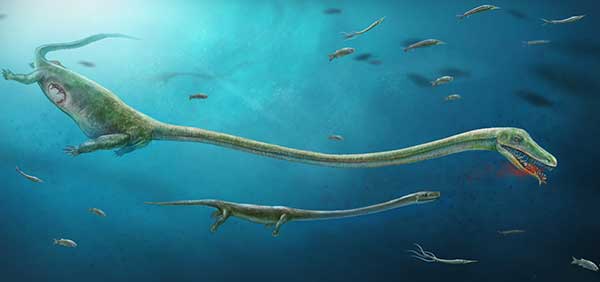Fossil offers clues to live births
|
An image released by Nature magazine in February shows a pregnant Dinocephalosaurus catching a fish.AFP |
Findings change understanding of vertebrate reproductive systems
A fossil of a long-necked marine reptile unearthed in Yunnan province shows the creature that lived millions of years before dinosaurs was developing an embryo, an indicator that it gave birth to live offspring, scientists said on Tuesday.
The discovery at the Luoping Biota National Geopark of the pregnant long-necked marine reptile that lived about 245 million years ago proved the live birth of the unusual fish-eating reptile, known as the Dinocephalosaurus, or terrible-headed lizard, according to research published in the journal Nature Communications.
"Our discovery pushes back evidence of reproductive biology in the group by roughly 50 million years, and shows that there is no fundamental reason to suggest that archosauromorphs, or ruling reptiles, did not give live birth," said Liu Jun, the lead author of the research and a paleontologist at Hefei University of Technology in Anhui province.
"Evidence of live birth among this category has never been discovered. The findings have changed our understanding of the evolution of vertebrate reproductive systems," he said.
Liu added that some reptiles - including about 20 percent of the world's 9,400 species of snakes and lizards - give birth to live young.
The fossil was uncovered along with another 20,000 fossils at the geopark in 2008.
With the help of other researchers, Liu was able to restore the fossil to its original shape and identify the creature in 2011. It is now preserved at the Chengdu Institute of Geology and Mineral Resources.
"I think you'd be amazed to see it, with its tiny head and long snaky neck," said Mike Benton, a paleontologist a the University of Bristol, who took part in the research.
The species had one of the longest necks relative to body size of any living creature to have existed. It was an estimated 4 meters long, with a slender neck roughly 1.7 meters long, Liu said. It had paddle-like flippers, a small head and a mouth with teeth, including large canines, perfect for snaring fish.
"The identification of the embryo as the reptile's baby, rather than one of its hearty meals, proved key to the whole research.
"In aquatic amniotes, prey is usually swallowed head first and this orientation is maintained during digestion and disarticulation. Therefore, the neck-forward position of the embryonic skeleton suggests that the included skeleton was not ingested prey, but was an embryo," the researchers wrote.
"We note that the embryo demonstrates the curled posture typical associated with vertebrate embryos."
Liu said the fact that the Dinocephalosaurus did not lay eggs has its advantages, as having live births would have been highly adaptive to reproduction in the sea.
"It is also an indicator that marine reptiles practically dominated the oceans at that time," he added.
Reuters contributed to this story.




















